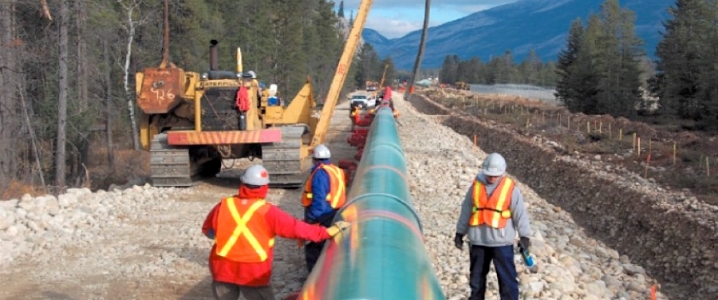The amount of oil available for export from Canada exceeded its takeaway pipeline capacity by about 310,000 bpd at the end of 2017, forcing steep discounts for Canadian oil.
The discount for Western Canada Select (WCS) relative to WTI hit $30 per barrel late last year, after the temporary outage of the Keystone pipeline. While that problem was resolved, the WCS discount has largely been stuck at about the same level through early March.
The problem for Canadian oil producers is that some new oil sands projects came online late last year, adding new supply. At the end of last year, Canadian output stood 350,000 bpd higher compared to two years earlier, despite no major pipelines coming online in that timeframe. Now, producers are fighting for space on the nation’s major pipelines, while new projects remain mired in limbo due to a mix of environmental opposition, regulatory hurdles and legal mess.
The problem won’t be resolved in the near future, even as upstream production continues to come online. “With no new investments in 2018 and production forecast to grow, we expect line space shortages to become more acute,” the IEA wrote in its new Oil 2018 report.
The bottleneck has put more pressure on the rail industry, but for various reasons, rail probably won’t solve the industry’s problems. Rail is not optimal in any case, costing as much as $7 to $8 per barrel more to ship oil to the U.S. Gulf Coast compared to the same route via pipeline, according to the IEA. Related: Shell Takes Major Steps Toward Energy Diversification
“While rail shipments have picked up in recent months and there is plenty of notional capacity, new rail car standards, which resulted in the decommissioning of a lot of older units, competition from grain exports and a lack of trained staff have made it hard to ramp up exports quickly,” the IEA said.
Moreover, rail companies are not going to make long-term investments in new rail capacity based on oil market conditions that might clear up in two or three years. “The standoff has hampered rail flows and may well continue over the next few months,” the IEA concluded.
Rail might begin to pick up some slack, but the pipeline problem could last a lot longer than a few months. The three main projects on the drawing board all still face significant challenges:
• Trans Mountain Expansion: Kinder Morgan’s proposed twin pipeline that would run alongside an existing line would nearly triple the system’s capacity to 890,000 bpd, carrying Alberta oil to the Pacific Coast in British Columbia. The project has the backing of the federal government, but not the BC provincial government. It also has run into opposition from First Nations and environmental groups. If it moves forward, the project probably wouldn’t come online until 2021 at the earliest, according to the IEA, which ranks the likelihood of the project getting off the ground as “uncertain.”
• Keystone XL: Like a zombie, this project refuses to die, despite a decade of legal haggling. TransCanada’s infamous pipeline has been approved by the Trump administration, but faces legal troubles in Nebraska, where state regulators only approved it for an alternative route, opening the project up to new legal problems. Meanwhile, the pipeline company still hasn’t given it a final investment decision, amid reports last year that it was struggling to line up customers. The IEA says this project is also “uncertain,” but if it moved forward, it wouldn’t come online until mid-2021.
• Line 3 Expansion: Enbridge is hoping to upgrade and overhaul its existing Line 3, which runs from Hardisty, Alberta to Superior, Wisconsin, allowing Canadian oil to move to the Midwest for refining. Enbridge has received the go-ahead from Canada but is still awaiting permits from the state of Minnesota, and a decision could still be a few more months away. Still, the IEA says this project is the most likely to go forward, and could begin operations at the end of next year. Related: Shale Boom Could Create A Refining Bottleneck
In short, Canada’s pipeline problems could be resolved with the addition of one or two projects, but in the most optimistic scenario, that could be nearly two years away. The IEA forecasts capacity rising by 450,000 bpd by the end of 2019, largely because it assumes the completion of the Line 3 expansion.
As upstream oil production trickles online, the IEA sees Canadian output exceeding pipeline capacity through 2020, which will force producers to turn to rail. And while there are short-term snags on Canadian railways, once those are resolved, oil-by-rail exports from Canada will “enjoy a renaissance, growing from their current 150 kb/d to an implied 250 kb/d on average in 2018 and 390 kb/d in 2019,” the IEA concludes. The agency says that oil-by-rail shipments could peak at 590,000 bpd in 2019.
That could help ease some pressure for oil producers, though not all of it. WCS trades at a more than $30-per-barrel discount to WTI right now because of both the backlog on the nation’s pipeline system, and the inability of the rail industry to quickly ramp up oil shipments. The IEA says the discount will fall back a bit to $20-$25 per barrel as rail picks up some slack. But that discount might not narrow any further until new pipelines are built.
By Nick Cunningham of Oilprice.com
More Top Reads From Oilprice.com
- Chevron: We Will Survive Under Any Climate Change Scenario
- One Of The World’s Largest Crude Storage Facilities Has Been Emptied
- Trump’s Trade Wars Could Spark A Massive Drop In Oil

















